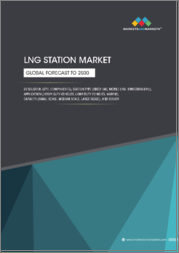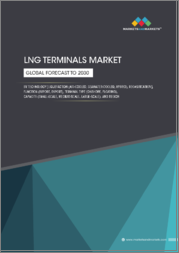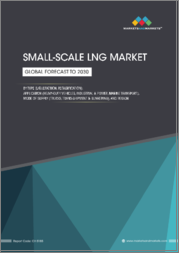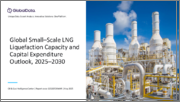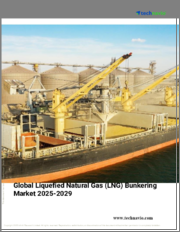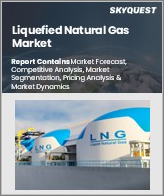
|
시장보고서
상품코드
1608927
세계의 액화천연가스(LNG) 시장 : 유형별, 용도별 예측(2025-2030년)Liquefied Natural Gas Market by Type (Liquefaction Terminal, Regasification Terminal), Application (Commercial, Industrial, Marine) - Global Forecast 2025-2030 |
||||||
액화천연가스(LNG) 시장의 2023년 시장 규모는 1,252억 5,000만 달러로 평가되었습니다. 2024년에는 1,334억 1,000만 달러에 이를 것으로 예측되며, 복합 연간 성장률(CAGR) 8.02%로 성장하여, 2030년에는 2,149억 7,000만 달러에 달할 것으로 예상됩니다.
액화천연가스(LNG) 시장은 저장 및 운송을 용이하게 하기 위해 액체 형태로 냉각된 천연가스의 생산, 운송, 소비를 중심으로 하는 산업분야로 정의됩니다. 석유를 대체하는 더 깨끗한 대체 에너지 역할로 인해 탄소 배출량을 줄이고 환경 규제 및 온실 가스 배출량을 줄이는 데 도움이 될 것입니다. 대체 연료와 같은 파이프라인에 의한 직접 공급 급여가 불가능한 산업에서 매우 중요합니다. 최종 용도의 범위에는 주로 발전, 산업 사업, 주택 난방, 수송이 포함됩니다. 진보, 신흥국 시장 인프라 개척, 깨끗한 에너지 이용을 촉진하는 정부의 지원 정책 등을 들 수 있습니다. 진출, 공급망, 운영 최적화를 위한 디지털 솔루션의 통합에 있습니다. 가능한 에너지와 경쟁과 같은 한계에 직면하고 있습니다. 과제로는 천연 가스 가격의 변동, 메탄 배출에 대한 우려, 인프라의 병목 현상 등을 들 수 있습니다. 기술 고도화, 니 지시장용 소규모 LNG 프로젝트 개척, 예지보전과 효율적인 물류관리를 위한 IoT, AI 툴 도입 등이 중점 분야가 될 수 있습니다. 변화와 환경에 대한 배려로 이로 인해 발생하는 큰 불확실성을 모두 특징으로 하는 역동적인 성격을 보여줍니다. 에 매우 중요합니다.
| 주요 시장 통계 | |
|---|---|
| 기준년(2023) | 1,252억 5,000만 달러 |
| 추정년(2024) | 1,334억 1,000만 달러 |
| 예측년(2030) | 2,149억 7,000만 달러 |
| 복합 연간 성장률(CAGR)(%) | 8.02% |
시장 역학 : 빠르게 진화하는 액화천연가스(LNG) 시장의 주요 시장 인사이트 공개
액화천연가스(LNG) 시장은 수요 및 공급의 역동적인 상호작용에 의해 변모를 이루고 있습니다. 새로운 비즈니스 기회를 획득할 수 있습니다. 이러한 동향을 종합적으로 파악함으로써 기업은 정치적, 지리적, 기술적, 사회적, 경제적 영역에 걸친 다양한 리스크를 경감할 수 있을 뿐만 아니라, 소비자 행동과 그것이 제조 비용 또는 구매 동향에 미치는 영향을보다 명확하게 이해할 수 있습니다.
- 시장 성장 촉진요인
- 다운스트림 산업으로부터의 천연 가스 수요의 급증
- 파이프라인 제약에 있어서 정부의 유리한 정책
- 급속한 산업화와 석유화학 등 전력 관련 프로젝트 증가
- 시장 성장 억제요인
- 원격지에서의 적절한 파이프라인 구조의 부족
- 시장 기회
- 새로운 LNG 인프라와 생산 프로젝트의 상승
- 보다 깨끗한 에너지원에 대한 인식과 기호의 고조
- 시장의 과제
- LNG 제조 및 운송에서 엄격한 규제 프로토콜
Porter's Five Forces : 액화천연가스(LNG) 시장을 탐색하는 전략 도구
Porter's Five Forces Framework는 시장 상황경쟁 구도를 이해하는 중요한 도구입니다. Porter's Five Forces Framework는 기업의 경쟁력을 평가하고 전략적 기회를 탐구하는 명확한 기술을 제공합니다. 이 프레임워크는 기업이 시장 내 세력도를 평가하고 신규 사업의 수익성을 판단하는 데 도움이 됩니다. 이러한 인사이트을 통해 기업은 자사의 강점을 활용하고 약점을 해결하고 잠재적인 과제를 피함으로써 보다 강인한 시장에서의 포지셔닝을 확보할 수 있습니다.
PESTLE 분석 : 액화천연가스(LNG) 시장에서 외부로부터의 영향 파악
외부 거시 환경 요인은 액화천연가스(LNG) 시장의 성과 역학을 형성하는 데 매우 중요한 역할을합니다. 정치적, 경제적, 사회적, 기술적, 법적, 환경적 요인 분석은 이러한 영향을 탐색하는 데 필요한 정보를 제공합니다. PESTLE 요인을 조사함으로써 기업은 잠재적인 위험과 기회를 더 잘 이해할 수 있습니다. 이 분석을 통해 기업은 규제, 소비자 선호, 경제 동향의 변화를 예측하고 앞으로 예상되는 적극적인 의사 결정을 할 준비가 가능합니다.
시장 점유율 분석 액화천연가스(LNG) 시장 경쟁 구도 파악
액화천연가스(LNG) 시장의 상세한 시장 점유율 분석을 통해 공급업체의 성과를 종합적으로 평가할 수 있습니다. 기업은 수익, 고객 기반, 성장률 등 주요 지표를 비교하여 경쟁 포지셔닝을 밝힐 수 있습니다. 이 분석을 통해 시장 집중, 단편화, 통합 동향을 밝혀내고 벤더들은 경쟁이 치열해지는 가운데 자사의 지위를 높이는 전략적 의사 결정을 내리는 데 필요한 지식을 얻을 수 있습니다.
FPNV 포지셔닝 매트릭스 액화천연가스(LNG) 시장에서 공급업체의 성능 평가
FPNV 포지셔닝 매트릭스는 액화천연가스(LNG) 시장에서 벤더를 평가하는 중요한 도구입니다. 이 행렬을 통해 비즈니스 조직은 공급업체의 비즈니스 전략과 제품 만족도를 기준으로 평가하여 목표에 맞는 충분한 정보를 바탕으로 의사 결정을 내릴 수 있습니다. 네 가지 사분면을 통해 공급업체를 명확하고 정확하게 세분화하여 전략 목표에 가장 적합한 파트너 및 솔루션을 파악할 수 있습니다.
전략분석과 추천액화천연가스시장에서 성공을 위한 길을 그립니다.
액화천연가스(LNG) 시장의 전략분석은 시장에서의 프레즌스 강화를 목표로 하는 기업에 필수적입니다. 이 접근법을 통해 경쟁 구도에서 과제를 극복하고 새로운 비즈니스 기회를 활용하여 장기적인 성공을 거둘 수 있는 시스템을 구축할 수 있습니다.
이 보고서는 주요 관심 분야를 포괄하는 시장의 종합적인 분석을 제공합니다.
1. 시장 침투 : 현재 시장 환경의 상세한 검토, 주요 기업의 광범위한 데이터, 시장 도달범위 및 전반적인 영향력 평가.
2. 시장 개척도 : 신흥 시장의 성장 기회를 파악하고 기존 분야의 확장 가능성을 평가하며 미래 성장을 위한 전략적 로드맵을 제공합니다.
3. 시장 다양화 : 최근 제품 출시, 미개척 지역, 업계의 주요 진보, 시장을 형성하는 전략적 투자를 분석합니다.
4. 경쟁 평가 및 정보 : 경쟁 구도를 철저히 분석하여 시장 점유율, 사업 전략, 제품 포트폴리오, 인증, 규제 당국 승인, 특허 동향, 주요 기업의 기술 진보 등을 검증합니다.
5. 제품 개발 및 혁신 : 미래 시장 성장을 가속할 것으로 예상되는 최첨단 기술, R&D 활동, 제품 혁신을 강조합니다.
또한 이해관계자가 충분한 정보를 얻고 의사결정을 할 수 있도록 중요한 질문에 대답하고 있습니다.
1. 현재 시장 규모와 향후 성장 예측은?
2. 최고의 투자 기회를 제공하는 제품, 부문 및 지역은 어디입니까?
3. 시장을 형성하는 주요 기술 동향과 규제의 영향은?
4. 주요 벤더의 시장 점유율과 경쟁 포지션은?
5. 벤더 시장 진입, 철수 전략의 원동력이 되는 수익원과 전략적 기회는 무엇인가?
목차
제1장 서문
제2장 조사 방법
제3장 주요 요약
제4장 시장 개요
제5장 시장 인사이트
- 시장 역학
- 성장 촉진요인
- 하류 산업으로부터의 천연 가스 수요의 급증
- 파이프라인 축소에 대한 정부의 유리한 정책
- 급속한 산업화와 석유화학 등 전력 관련 프로젝트 증가
- 억제요인
- 원격지에서의 적절한 파이프라인 구조의 부족
- 기회
- LNG를 위한 새로운 인프라와 생산 프로젝트의 출현
- 보다 깨끗한 에너지원에 대한 의식과 취향 증가
- 과제
- LNG 제조 및 운송에서 엄격한 규제 프로토콜
- 성장 촉진요인
- 시장 세분화 분석
- Porter's Five Forces 분석
- PESTEL 분석
- 정치적
- 경제
- 사교
- 기술적
- 법률상
- 환경
제6장 액화천연가스(LNG) 시장 : 유형별
- 액화 터미널
- 재기화 터미널
제7장 액화천연가스(LNG) 시장 : 용도별
- 상업용
- 산업
- 해양
- 주택용
- 교통기관
- 유틸리티
제8장 아메리카의 액화천연가스(LNG) 시장
- 아르헨티나
- 브라질
- 캐나다
- 멕시코
- 미국
제9장 아시아태평양의 액화천연가스(LNG) 시장
- 호주
- 중국
- 인도
- 인도네시아
- 일본
- 말레이시아
- 필리핀
- 싱가포르
- 한국
- 대만
- 태국
- 베트남
제10장 유럽, 중동 및 아프리카의 액화천연가스(LNG) 시장
- 덴마크
- 이집트
- 핀란드
- 프랑스
- 독일
- 이스라엘
- 이탈리아
- 네덜란드
- 나이지리아
- 노르웨이
- 폴란드
- 카타르
- 러시아
- 사우디아라비아
- 남아프리카
- 스페인
- 스웨덴
- 스위스
- 터키
- 아랍에미리트(UAE)
- 영국
제11장 경쟁 구도
- 시장 점유율 분석(2023년)
- FPNV 포지셔닝 매트릭스(2023년)
- 경쟁 시나리오 분석
- 전략 분석과 제안
기업 목록
- Anadarko Petroleum Corporation
- BP Plc
- Cheniere Energy, Inc.
- Chevron Corporation
- China National Petroleum Corporation
- ConocoPhillips Company
- Eni SpA
- Equinor ASA
- Exxon Mobil Corporation
- INPEX Corporation
- Linde GmbH
- National Iranian Oil Company
- PetroChina Company Limited
- Petronet LNG Limited
- Royal Dutch Shell PLC
- Snam SpA
The Liquefied Natural Gas Market was valued at USD 125.25 billion in 2023, expected to reach USD 133.41 billion in 2024, and is projected to grow at a CAGR of 8.02%, to USD 214.97 billion by 2030.
The Liquefied Natural Gas (LNG) market is defined as the industry segment centered around the production, transportation, and consumption of natural gas that has been cooled to a liquid form for ease of storage or transport. The necessity of LNG arises from its role as a cleaner alternative to coal and oil, offering lower carbon emissions and helping meet environmental regulations and commitments towards reducing greenhouse gas emissions. Its application is crucial in industries where direct pipeline delivery is not feasible, such as in maritime transportation, remote power generation, and as a fuel alternative for heavy-duty vehicles, ferries, and trains. The end-use scope primarily includes electricity generation, industrial operations, residential heating, and transportation. Key growth influencers include increasing global energy demand, advancements in liquefaction technology, infrastructural development in emerging markets, and supportive governmental policies promoting clean energy usage. Potential opportunities reside in technological innovations aimed at enhancing the efficiency and safety of liquefaction and regasification processes, expansion into untapped markets particularly in Asia and Africa, and integration of digital solutions to optimize supply chain operations. However, market growth faces limitations such as high initial capital investment, geopolitical tensions affecting gas supply, and competition from renewable energy sources that could affect LNG adoption rates. Challenges include fluctuating natural gas prices, concerns over methane emissions, and infrastructure bottlenecks. For business growth through research and innovation, focus areas could include advancing carbon capture and storage technologies, developing small-scale LNG projects to serve niche markets, and implementing IoT and AI tools for predictive maintenance and efficient logistics management. The LNG market exhibits a dynamic nature characterized by both robust growth potential and considerable uncertainty driven by shifting global energy landscapes and environmental considerations. Employing a strategic approach to capitalize on emerging trends while mitigating risks will be crucial for stakeholders in this evolving market.
| KEY MARKET STATISTICS | |
|---|---|
| Base Year [2023] | USD 125.25 billion |
| Estimated Year [2024] | USD 133.41 billion |
| Forecast Year [2030] | USD 214.97 billion |
| CAGR (%) | 8.02% |
Market Dynamics: Unveiling Key Market Insights in the Rapidly Evolving Liquefied Natural Gas Market
The Liquefied Natural Gas Market is undergoing transformative changes driven by a dynamic interplay of supply and demand factors. Understanding these evolving market dynamics prepares business organizations to make informed investment decisions, refine strategic decisions, and seize new opportunities. By gaining a comprehensive view of these trends, business organizations can mitigate various risks across political, geographic, technical, social, and economic domains while also gaining a clearer understanding of consumer behavior and its impact on manufacturing costs and purchasing trends.
- Market Drivers
- Proliferation in demand for natural gas from downstream industries
- Favorable government policies in the constriction of pipelines
- Rapid industrialization coupled with rise in power-related projects such as petrochemicals
- Market Restraints
- Dearth of adequate pipelines structures in remote areas
- Market Opportunities
- Emerging new infrastructure and production projects for LNG
- Increasing awareness and preference for cleaner energy sources
- Market Challenges
- Stringent regulatory protocols in the manufacture and transport of LNG
Porter's Five Forces: A Strategic Tool for Navigating the Liquefied Natural Gas Market
Porter's five forces framework is a critical tool for understanding the competitive landscape of the Liquefied Natural Gas Market. It offers business organizations with a clear methodology for evaluating their competitive positioning and exploring strategic opportunities. This framework helps businesses assess the power dynamics within the market and determine the profitability of new ventures. With these insights, business organizations can leverage their strengths, address weaknesses, and avoid potential challenges, ensuring a more resilient market positioning.
PESTLE Analysis: Navigating External Influences in the Liquefied Natural Gas Market
External macro-environmental factors play a pivotal role in shaping the performance dynamics of the Liquefied Natural Gas Market. Political, Economic, Social, Technological, Legal, and Environmental factors analysis provides the necessary information to navigate these influences. By examining PESTLE factors, businesses can better understand potential risks and opportunities. This analysis enables business organizations to anticipate changes in regulations, consumer preferences, and economic trends, ensuring they are prepared to make proactive, forward-thinking decisions.
Market Share Analysis: Understanding the Competitive Landscape in the Liquefied Natural Gas Market
A detailed market share analysis in the Liquefied Natural Gas Market provides a comprehensive assessment of vendors' performance. Companies can identify their competitive positioning by comparing key metrics, including revenue, customer base, and growth rates. This analysis highlights market concentration, fragmentation, and trends in consolidation, offering vendors the insights required to make strategic decisions that enhance their position in an increasingly competitive landscape.
FPNV Positioning Matrix: Evaluating Vendors' Performance in the Liquefied Natural Gas Market
The Forefront, Pathfinder, Niche, Vital (FPNV) Positioning Matrix is a critical tool for evaluating vendors within the Liquefied Natural Gas Market. This matrix enables business organizations to make well-informed decisions that align with their goals by assessing vendors based on their business strategy and product satisfaction. The four quadrants provide a clear and precise segmentation of vendors, helping users identify the right partners and solutions that best fit their strategic objectives.
Strategy Analysis & Recommendation: Charting a Path to Success in the Liquefied Natural Gas Market
A strategic analysis of the Liquefied Natural Gas Market is essential for businesses looking to strengthen their global market presence. By reviewing key resources, capabilities, and performance indicators, business organizations can identify growth opportunities and work toward improvement. This approach helps businesses navigate challenges in the competitive landscape and ensures they are well-positioned to capitalize on newer opportunities and drive long-term success.
Key Company Profiles
The report delves into recent significant developments in the Liquefied Natural Gas Market, highlighting leading vendors and their innovative profiles. These include Anadarko Petroleum Corporation, BP Plc, Cheniere Energy, Inc., Chevron Corporation, China National Petroleum Corporation, ConocoPhillips Company, Eni S.p.A, Equinor ASA, Exxon Mobil Corporation, INPEX Corporation, Linde GmbH, National Iranian Oil Company, PetroChina Company Limited, Petronet LNG Limited, Royal Dutch Shell PLC, and Snam S.p.A.
Market Segmentation & Coverage
This research report categorizes the Liquefied Natural Gas Market to forecast the revenues and analyze trends in each of the following sub-markets:
- Based on Type, market is studied across Liquefaction Terminal and Regasification Terminal.
- Based on Application, market is studied across Commercial, Industrial, Marine, Residential, Transportation, and Utilities.
- Based on Region, market is studied across Americas, Asia-Pacific, and Europe, Middle East & Africa. The Americas is further studied across Argentina, Brazil, Canada, Mexico, and United States. The United States is further studied across California, Florida, Illinois, New York, Ohio, Pennsylvania, and Texas. The Asia-Pacific is further studied across Australia, China, India, Indonesia, Japan, Malaysia, Philippines, Singapore, South Korea, Taiwan, Thailand, and Vietnam. The Europe, Middle East & Africa is further studied across Denmark, Egypt, Finland, France, Germany, Israel, Italy, Netherlands, Nigeria, Norway, Poland, Qatar, Russia, Saudi Arabia, South Africa, Spain, Sweden, Switzerland, Turkey, United Arab Emirates, and United Kingdom.
The report offers a comprehensive analysis of the market, covering key focus areas:
1. Market Penetration: A detailed review of the current market environment, including extensive data from top industry players, evaluating their market reach and overall influence.
2. Market Development: Identifies growth opportunities in emerging markets and assesses expansion potential in established sectors, providing a strategic roadmap for future growth.
3. Market Diversification: Analyzes recent product launches, untapped geographic regions, major industry advancements, and strategic investments reshaping the market.
4. Competitive Assessment & Intelligence: Provides a thorough analysis of the competitive landscape, examining market share, business strategies, product portfolios, certifications, regulatory approvals, patent trends, and technological advancements of key players.
5. Product Development & Innovation: Highlights cutting-edge technologies, R&D activities, and product innovations expected to drive future market growth.
The report also answers critical questions to aid stakeholders in making informed decisions:
1. What is the current market size, and what is the forecasted growth?
2. Which products, segments, and regions offer the best investment opportunities?
3. What are the key technology trends and regulatory influences shaping the market?
4. How do leading vendors rank in terms of market share and competitive positioning?
5. What revenue sources and strategic opportunities drive vendors' market entry or exit strategies?
Table of Contents
1. Preface
- 1.1. Objectives of the Study
- 1.2. Market Segmentation & Coverage
- 1.3. Years Considered for the Study
- 1.4. Currency & Pricing
- 1.5. Language
- 1.6. Stakeholders
2. Research Methodology
- 2.1. Define: Research Objective
- 2.2. Determine: Research Design
- 2.3. Prepare: Research Instrument
- 2.4. Collect: Data Source
- 2.5. Analyze: Data Interpretation
- 2.6. Formulate: Data Verification
- 2.7. Publish: Research Report
- 2.8. Repeat: Report Update
3. Executive Summary
4. Market Overview
5. Market Insights
- 5.1. Market Dynamics
- 5.1.1. Drivers
- 5.1.1.1. Proliferation in demand for natural gas from downstream industries
- 5.1.1.2. Favorable government policies in the constriction of pipelines
- 5.1.1.3. Rapid industrialization coupled with rise in power-related projects such as petrochemicals
- 5.1.2. Restraints
- 5.1.2.1. Dearth of adequate pipelines structures in remote areas
- 5.1.3. Opportunities
- 5.1.3.1. Emerging new infrastructure and production projects for LNG
- 5.1.3.2. Increasing awareness and preference for cleaner energy sources
- 5.1.4. Challenges
- 5.1.4.1. Stringent regulatory protocols in the manufacture and transport of LNG
- 5.1.1. Drivers
- 5.2. Market Segmentation Analysis
- 5.3. Porter's Five Forces Analysis
- 5.3.1. Threat of New Entrants
- 5.3.2. Threat of Substitutes
- 5.3.3. Bargaining Power of Customers
- 5.3.4. Bargaining Power of Suppliers
- 5.3.5. Industry Rivalry
- 5.4. PESTLE Analysis
- 5.4.1. Political
- 5.4.2. Economic
- 5.4.3. Social
- 5.4.4. Technological
- 5.4.5. Legal
- 5.4.6. Environmental
6. Liquefied Natural Gas Market, by Type
- 6.1. Introduction
- 6.2. Liquefaction Terminal
- 6.3. Regasification Terminal
7. Liquefied Natural Gas Market, by Application
- 7.1. Introduction
- 7.2. Commercial
- 7.3. Industrial
- 7.4. Marine
- 7.5. Residential
- 7.6. Transportation
- 7.7. Utilities
8. Americas Liquefied Natural Gas Market
- 8.1. Introduction
- 8.2. Argentina
- 8.3. Brazil
- 8.4. Canada
- 8.5. Mexico
- 8.6. United States
9. Asia-Pacific Liquefied Natural Gas Market
- 9.1. Introduction
- 9.2. Australia
- 9.3. China
- 9.4. India
- 9.5. Indonesia
- 9.6. Japan
- 9.7. Malaysia
- 9.8. Philippines
- 9.9. Singapore
- 9.10. South Korea
- 9.11. Taiwan
- 9.12. Thailand
- 9.13. Vietnam
10. Europe, Middle East & Africa Liquefied Natural Gas Market
- 10.1. Introduction
- 10.2. Denmark
- 10.3. Egypt
- 10.4. Finland
- 10.5. France
- 10.6. Germany
- 10.7. Israel
- 10.8. Italy
- 10.9. Netherlands
- 10.10. Nigeria
- 10.11. Norway
- 10.12. Poland
- 10.13. Qatar
- 10.14. Russia
- 10.15. Saudi Arabia
- 10.16. South Africa
- 10.17. Spain
- 10.18. Sweden
- 10.19. Switzerland
- 10.20. Turkey
- 10.21. United Arab Emirates
- 10.22. United Kingdom
11. Competitive Landscape
- 11.1. Market Share Analysis, 2023
- 11.2. FPNV Positioning Matrix, 2023
- 11.3. Competitive Scenario Analysis
- 11.4. Strategy Analysis & Recommendation
Companies Mentioned
- 1. Anadarko Petroleum Corporation
- 2. BP Plc
- 3. Cheniere Energy, Inc.
- 4. Chevron Corporation
- 5. China National Petroleum Corporation
- 6. ConocoPhillips Company
- 7. Eni S.p.A
- 8. Equinor ASA
- 9. Exxon Mobil Corporation
- 10. INPEX Corporation
- 11. Linde GmbH
- 12. National Iranian Oil Company
- 13. PetroChina Company Limited
- 14. Petronet LNG Limited
- 15. Royal Dutch Shell PLC
- 16. Snam S.p.A






